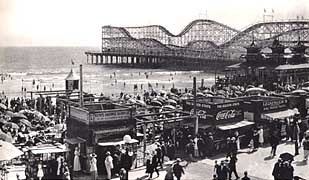Bluff Heights Neighborhood Association
The History of Long Beach

A brief chronological glance at our city's past
Just 50 years after Columbus discovered America, Cabrillo and his crew of explorers anchored off the present site of Long Beach. Vast clouds of smoke were rolling high in the sky from burning grass and brush ashore where the native Indians were conducting one of their periodic rabbit drives. Cabrillo named the area “Bahia de los Fumos” -- the Bay of Smokes.
The first modern identity for Long Beach began with the sprawling rancho awarded Manuel Nieto in 1784. Time and descendants divided the old Spanish Land Grant until the bulk of what is now Long Beach was contained in two ranchos, Los Cerritos and Los Alamitos.
In 1880, William Erwin Willmore, an Englishman and Long Beach’s first real estate developer, subdivided a portion of Los Cerritos. With the advent of two parties of settlers in 1882, the township of Willmore City was launched. By 1884, with only a dozen houses in the settlement, Willmore City had failed, and the founder departed for Arizona. However, people still straggled in, and in 1888 with 59 buildings and a new school, the newly named City of Long Beach was first incorporated. Nine years later, dissatisfaction with prohibition and high taxes led to an abortive and short-lived disincorporation. Before the year 1897 was out, the citizens voted to reincorporate, and Long Beach has continued to grow ever since. From a population of 1,500 and an area of three square miles in 1897, the City has grown to an estimated population of 440,000 citizens living in a 50-square-mile area.
1784 The area that is now Long Beach was first settled as part of a massive Spanish land grant to soldier Manuel Nieto, encompassing the historic 28,000-acre Ranch Los Alamitos and its sister rancho, 27,000 acre Rancho Los Cerritos.
1866 Rancho Los Cerritos was sold to Lewellyn Bixby and then managed by his brother Jotham. The Bixby family soon become prominent ranchers and developers of Long Beach and remain even to this day.
1882 First planned as Willmore City by developer William Willmore, a new town began forming along the coast.
1885 Competition between the new Santa Fe Railroad and older southern Pacific Railroad attracted hordes of visitors to Long Beach and created a real estate boom.
1888 Original residents of the foiled Willmore City renamed their town Long Beach, after its long, wide beaches, and the city became incorporated.
1902 The introduction of the Pacific Electric trolley caused the city to grow both as a resort and commercial center.
1902-1910 Long Beach was the fastest growing city in the United States.
1911 The Port of Long Beach was established.
1921 Oil was discovered on Signal Hill and Long Beach flourished with a million- dollar-per-month building boom downtown.
1933 Long Beach was struck by a major earthquake. Downtown Long Beach was rebuilt in Art Deco style.
1936 More oil was discovered and the port expanded and improved its facilities.
1941 The U.S. Naval base was constructed in the harbor area.
1947 The first and only flight of Howard Hughes' Spruce Goose, the world's largest airplane, took off over Long Beach Harbor.
1949 California State University Long Beach was founded.
1967 The city of Long Beach purchased Cunard's former luxury cruise liner, the Queen Mary, to be docked in Long Beach Harbor as a major tourism attraction and hotel.
1974 The State Coastal Commission turned over control of downtown redevelopment to the city.
1976 The city embarked on a multi-billion dollar redevelopment program to continue through the year 2000.
1978 The Long Beach Convention & Entertainment Center opened, adjacent to the Long Beach arena.
1982 Shoreline Village, the Downtown Shoreline Marina and Shoreline Park opened.
1983 The Spruce Goose was moved from its hidden hangar to be exhibited in the world's largest geodesic dome adjacent to the Queen Mary.
1984 Long Beach was the site for four Olympic events during the Los Angeles Olympics-- yachting, volleyball, fencing and archery.
1988 Long Beach celebrated its Centennial.
1989 The Greater Los Angeles World Trade Center in Long Beach opened.
1990 The Long Beach to Los Angeles Metro Blue Line, the first link in the Los Angeles Metro Rail project, started service.
1992 Construction began on an expansion to the Long Beach Convention & Entertainment Center to triple the size of its exhibit facilities.
The Spruce goose is moved to McMinnville, Oregon to become the centerpiece for the Air Venture Museum, its dome is "converted" to use as movie studio by Warner Bros.
Pine Square, Southern California's second-largest movie theater complex with 16 screens, shops and restaurants opened December 18.
1994 Completion of the Long Beach Convention & Entertainment Center expansion, tripling the existing exhibit space to 334,000 square feet.
1995 Groundbreaking is held on the $100 million, 120,000-square-foot Aquarium of the Pacific, the largest such project ever in Southern California and the centerpiece of a $650 million renovation of the Long Beach waterfront.
1996 The historic Queen Mary celebrates the 60th anniversary of its 1936 maiden voyage from Southampton, England, to New York City.


